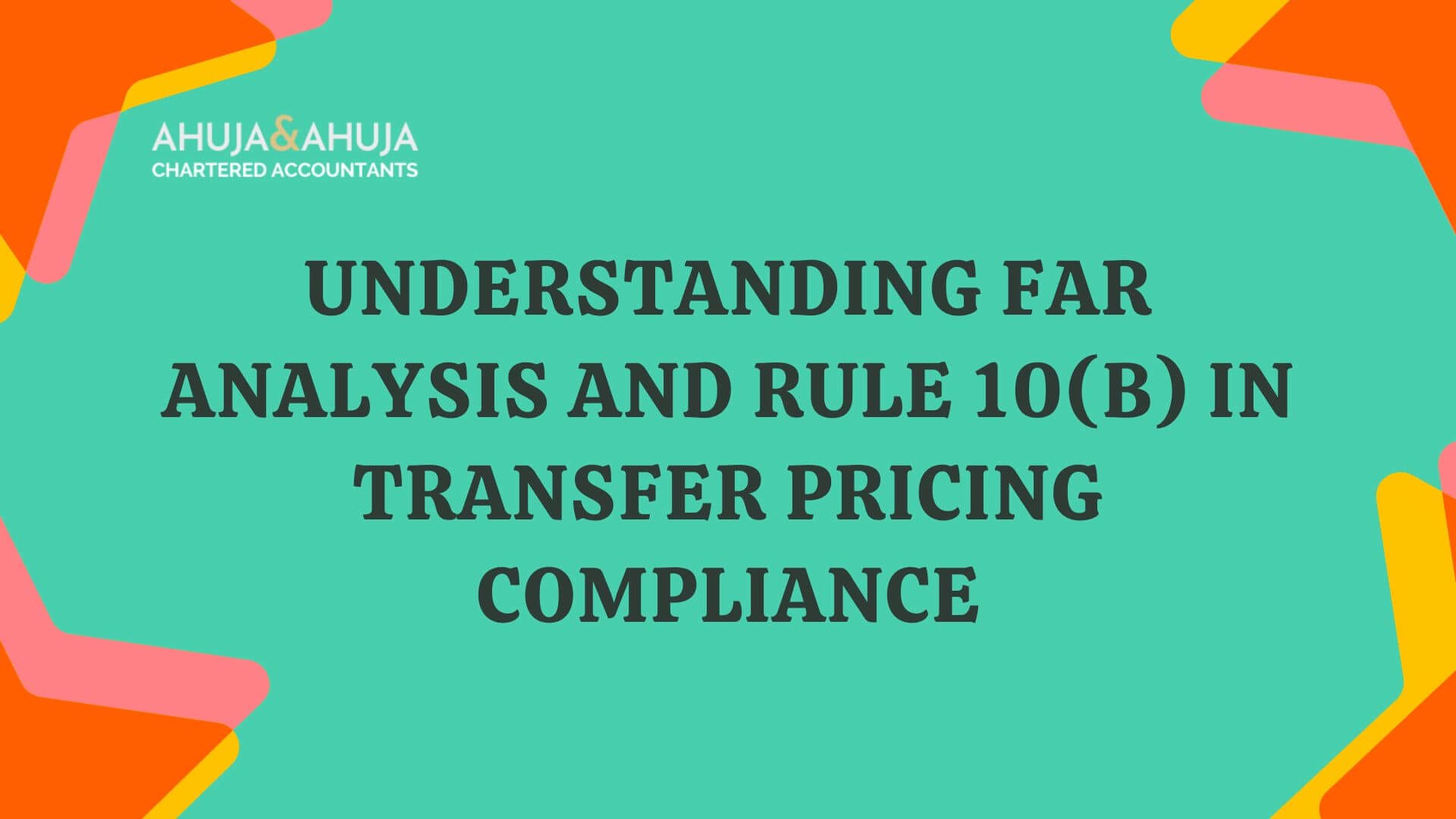Understanding FAR Analysis and Rule 10(B) in Transfer Pricing Compliance
In the multifaceted world of international business and taxation, transfer pricing stands out as a critical concern for multinational corporations.
It involves setting the prices for goods and services transferred between related legal entities within an enterprise, ensuring that businesses meet local compliance standards and optimize their tax obligations. A robust framework to assess these internal transactions is essential.
This is where Function, Assets, and Risks (FAR) Analysis and Rule 10(B) under the Income Tax Rules play a pivotal role.
The concept of FAR Analysis underlines a systematic method to evaluate the roles, resources, and risks associated with entities partaking in controlled transactions.
This process forms the backbone of the comparability analysis, which helps determine if the transactions are priced at arm’s length, an essential measure to ensure tax compliance and economic efficiency.
Understanding these elements is not just crucial for compliance but also for maintaining strategic operational alignment within multinational groups. It supports in rooting out any disparities that could attract legal scrutiny or lead to significant fiscal penalties.
Section 1: Understanding FAR Analysis
What is FAR Analysis?
Function, Assets, and Risks (FAR) Analysis is a structured approach used in transfer pricing to compare the functions performed, assets utilized, and risks assumed by parties in both controlled (intra-group) and uncontrolled (open market) transactions.
This comparative assessment is essential in transfer pricing as it ensures that transactions between associated enterprises are conducted at arm’s length, meaning they are no different than transactions with independent parties.
Components of FAR Analysis
Functions
The functions performed by entities involved in the transactions include a wide range of activities such as manufacturing, development, service provisioning, sales, marketing, and support.
Understanding what each party is actually doing is crucial in the valuation of transactions. For example, a company solely involved in manufacturing may have less operational risk than one that also handles marketing and sales.
Assets
This refers to both tangible and intangible assets employed in conducting business activities. Tangible assets include machinery, buildings, and vehicles, while intangible assets could be patents, trademarks, or software.
Assets are a core component because they represent the capital invested and the capacity of the business to generate income.
Risks
Risk assessment covers the types of risks each party assumes. These can be financial risks, market risks, credit risks, or even operational risks associated with R&D.
Typically, higher risk warrants a higher return, making this aspect vital in evaluating transactional profitability and sustainability.
Importance of FAR Analysis
FAR analysis does not only support regulatory compliance but also enhances transparency and operational clarity within the enterprise.
This analysis acts as a preemptive measure to align international transactions with market standards, thereby mitigating risks of legal non-compliance and economic repercussions.
Linking theory to practice, let’s consider it in light of significant legal precedents and guidelines. The landmark judgement by the Supreme Court in Morgan Stanley and Company Inc. underscored the importance of thorough FAR analysis in establishing benchmarking for transfer pricing.
Similarly, insights from various cases, including the Hoganas India (P.) Ltd. v. Dy. CIT, have highlighted practical applications and challenges encountered in real-case scenarios.
Navigating Complexity in Transfer Pricing
To delve deeper into understanding transfer pricing and to see how FAR is applied according to Rule 10(B), an insightful resource can be found here.
Additionally, businesses looking to establish themselves in foreign markets must be aware of compliance nuances which may demand stringent adherence to FAR analysis associated with setting up foreign companies in India.
Detailed Look at Rule 10(B) of the Income Tax Rules
Exploring Rule 10(B)
Rule 10B of the Income Tax Rules of India plays a crucial role in the realm of transfer pricing by outlining the specific measures and criteria needed to ensure that international transactions are conducted at arm’s length.
This rule is designed to provide a clear guideline for evaluating the comparability of international transactions with uncontrolled or independent transactions.
Key Aspects of Rule 10(B)
Specific Characteristics of Properties or Services
- The rule necessitates comparing the specific characteristics of the property transferred or services provided. This includes physical features, quality, and availability of the property or services involved in the transactions.
Functions, Assets, and Risks
- As also highlighted in FAR analysis, Rule 10(B)(2) emphasizes the functions performed, assets employed, and risks assumed by the parties involved in the transactions. This alignment with FAR ensures comprehensive scrutiny of all pivotal aspects influencing transaction values.
Contractual Terms
- The terms of the transactions, which dictate the responsibilities, risks, and benefits, must be comparable. Formal or informal, these terms guide how transactions are structured and, consequently, priced.
Market Conditions
- The rule accounts for the conditions of the markets where the parties operate, including economic environment, competition level, market size, and geographical impacts on business operations. Understanding these elements is essential for a fair assessment of transaction values.
Comparability Adjustments
- Rule 10(B)(3) clarifies that for achieving comparability, adjustments must be made to account for any differences that might affect the pricing or the profits materially. This ensures that the transactions examined are on a level playing field with independent transactions under similar circumstances.
Practical Application of Rule 10(B)
In practical terms, Rule 10(B) requires businesses to meticulously document and justify their pricing mechanisms by aligning them with the market standards where similar uncontrolled transactions occur.
This detailed documentation is vital during tax assessments or audits where proof of compliance with the arm’s length principle is required.
For businesses expanding internationally, understanding and applying Rule 10(B) is crucial. It not only assures compliance with taxation norms but also safeguards against potential fiscal liabilities and penalties.
For detailed guidance on international taxation and setting up operations seamlessly across borders, companies must adapt to these regulatory frameworks diligently.
Section 3: Application and Case Studies
Case Studies in FAR Analysis and Rule 10(B)
Applying the theoretical framework of FAR Analysis and Rule 10(B) requires a careful examination of real-world cases. This section delves into several noteworthy legal precedents and case studies that highlight the practical applications and challenges inherent in transfer pricing assessments.
Key Case Studies
Morgan Stanley and Company Inc.
- In the landmark case of Morgan Stanley (Referenced at FC-TRS Form RBI transfer of shares resident non-resident), the Supreme Court emphasized the necessity of FAR analysis for establishing an arm’s length price.
This case set a precedent on the importance of detailed documentation and functional analysis in transfer pricing practices.
Hoganas India (P.) Ltd. vs. Dy. CIT
- The transaction involving Hoganas India dealt with discrepancies in commission rates on sales, which were benchmarked using the Transactional Net Margin Method (TNMM).
Differences in functions and risks between parent and subsidiary were deemed not comparably reflected, leading to adjustments by the Transfer Pricing Officer (TPO).
Wrigley India (P.) Ltd. vs. Addl. CIT
- This case involved comparisons of segments within the same company—domestic and export—and highlighted the need for comprehensive FAR profiles.
Despite similarities in manufacturing and infrastructure, regional factors and market conditions led to significant economic differences that had to be considered for a fair assessment under Rule 10(B).
E-Gain Communication (P) Ltd. vs. ITO
- In the E-Gain decision, the Pune Bench of the Tribunal emphasized that even when the TNMM is applied, it is crucial to consider the functions performed, assets employed, and risks assumed.
This reinforced the principle that comparable adjustments must be accurate and reflect the economic realities of the business environments (Further insights can be found in Setup foreign companies in India – compliance).
Importance of Contextual Understanding
These cases underscore the critical need for a deep understanding of the local business environment, market conditions, and operational specifics when applying FAR analysis and Rule 10(B).
Each case brings to light the complexities involved in ensuring transactions meet the arm’s length standard and align with both domestic and international regulations.
Practical Insights
- Documentation is Key: Rigorous documentation and detailed functional analysis are indispensable. This includes contracts, transactional records, and comprehensive descriptions of all business activities.
- Flexibility in Methods: Different cases might require different approaches. For instance, while TNMM might be suitable in one scenario, the cost-plus method might be essential in another, depending on the specific characteristics of the transactions.
- Regional Factors: Geographic and economic conditions play a crucial role and must always be factored into the analysis, ensuring that the comparisons are grounded in reality.
Through these case studies, we see the dynamic application of FAR analysis and Rule 10(B), demonstrating the variability and complexity in real-world scenarios.
Businesses and tax practitioners must remain vigilant and adaptable, employing a thorough understanding and strategic approach to navigate transfer pricing challenges effectively.
As these analyses show, the process of transfer pricing is not just about compliance but also about maintaining competitive parity and operational transparency in international business dealings.
The insights from these cases form a foundational basis for companies to approach transfer pricing not just as a fiscal obligation but as a core business strategy.
Comparability Factors in Transfer Pricing
Understanding Comparability Factors
Comparability analysis is the cornerstone of transfer pricing, ensuring that transactions between associated enterprises are conducted as if they were between independent entities.
This section explores the essential factors outlined by both US Regulations and the OECD Guidelines which are pivotal in achieving an accurate comparability analysis.
Key Comparability Factors:
Functions
- This involves a detailed analysis of the activities and processes each entity undertakes. Engaging in a thorough functional analysis helps delineate the contribution of each party to the transaction, balancing their roles against the compensation received or paid.
Assets
- Assets, both tangible and intangible, play a crucial role in generating value for businesses. Their evaluation helps in understanding the capacity and capability of an entity to undertake given transactions, influencing the pricing strategies.
Contractual Terms
- Terms outlined in agreements dictate the expectations and obligations of each party. Significant contractual clauses such as pricing terms, delivery conditions, and payment terms can greatly influence the economic outcomes of transactions.
Risks
- Assessing the risks assumed by each party is fundamental. Entities taking on greater risks typically expect higher returns, which should be accurately mirrored in transfer pricing evaluations.
Economic Conditions
- Economic conditions encompass market competition, geographical influences, and economic environments that directly affect business operations. Understanding these is essential to assess how external factors influence pricing and profitability.
Application of Comparability Factors
Integrating these factors into a comparability analysis involves a blend of qualitative and quantitative assessments.
Companies must gather and analyze a wide range of data including market reports, financial statements, and contractual agreements.
Practical application of these factors is well-demonstrated in the previously mentioned case studies, where each factor played a role in determining the arms’ length nature of intra-group transactions.
Tables and Bullet Points for Clarification:
| Factor | Description |
|---|---|
| Functions | What activities does each entity perform? (E.g., manufacturing, marketing, support) |
| Assets | What are the tangible and intangible assets involved? (E.g., technology, trademarks) |
| Contractual Terms | What are the key terms and conditions of the agreements? |
| Risks | What risks are associated and who assumes them? (E.g., market, credit risks) |
| Economic Conditions | What external economic factors affect the transaction? (E.g., market size, competition) |
Insights for Businesses:
- Businesses should aim for comprehensive documentation and systematic analysis regulating their transfer pricing policies.
- Engaging with skilled tax professionals and utilizing advanced analytical tools can provide a deeper insight into comparable transactions, enhancing compliance and strategy.
- Regular updates and revisions to transfer pricing documentation are crucial as business operations, market conditions, and regulatory landscapes evolve.
The role of comparability factors in transfer pricing cannot be overstated. They provide the framework necessary to ensure that transactions between associated enterprises are conducted on arm’s length terms, maintaining fairness and compliance in international tax matters.
As global business dynamics continue to evolve, so too must the approaches companies take to manage their transfer pricing policies.
With careful consideration of each comparability factor, businesses can better navigate the complexities of international trade and tax regulations.
Constructing a Robust FAR Analysis
Integrating FAR Analysis with Comparability Factors
To ensure a comprehensive understanding and implementation of transfer pricing, constructing a robust FAR Analysis is imperative.
FAR Analysis, when integrated with comparability factors, provides a meticulous framework for assessing and establishing arm’s length prices for international transactions.
Steps to Perform a Comprehensive FAR Analysis:
Identify the Functions, Assets, and Risks:
- Functions: Document all critical functions performed by the entities involved, such as production, research and development, sales, marketing, and support services.
- Assets: Catalogue all tangible and intangible assets that are significant to the transactions.
- Risks: Determine which party assumes significant risks and the nature of these risks.
Apply Comparability Factors:
- Assess each transaction against the standard comparability factors: functionalities, assets used, risks assumed, contractual terms, and economic conditions. This helps ensure that the analysis reflects fair market conditions.
Use Benchmarking Studies:
- Conduct benchmarking studies to find comparables that match or are sufficiently similar to the controlled transactions. Adjust for any material differences to ascertain an arm’s length range.
Prepare Documentation:
- Compile comprehensive documentation that records the analysis process, findings, and rationale for decisions or adjustments made. This is crucial for supporting the transfer pricing method chosen during any regulatory reviews or audits.
Review and Update Regularly:
- Continually monitor and update the FAR analysis in light of changing market conditions, business strategies, or regulatory requirements. This iterative process ensures ongoing compliance and relevance.
Using Tools and Technology in FAR Analysis:
Leveraging advanced analytics and financial technology can significantly enhance the accuracy and efficiency of FAR Analysis.
Tools such as data analytics software help in aggregating and analyzing large datasets to identify comparables, while AI-driven platforms can detect anomalies or outliers in pricing strategies more effectively.
Common Pitfalls and How to Avoid Them:
- Inadequate Documentation: Ensure all relevant data, calculations, and decisions are well-documented.
- Ignoring Market Changes: Regularly update FAR analysis to reflect current economic conditions and market trends.
- Overlooking Intangibles: Pay adequate attention to intangible assets which can significantly affect transfer pricing.
- Failing to Make Necessary Adjustments: Properly adjust for differences between the controlled and uncontrolled transactions to ensure comparability.
Final Words: Emphasizing Best Practices in Transfer Pricing
In navigating the complexities of international taxation and transfer pricing, FAR Analysis serves as a foundational pillar, ensuring that businesses remain compliant while optimizing their tax obligations.
By integrating FAR with detailed comparability factors and leveraging technological advancements, companies can achieve a more transparent and defendable transfer pricing strategy.
We have observed through various case studies and practical applications how consistently applying these principles aids in maintaining fair and competitive business practices across borders.
For businesses looking to establish or expand their international presence, an adept understanding and application of FAR and Rule 10(B) are indispensable.
By fostering a rigorous and informed approach to transfer pricing, businesses not only adhere to global tax laws but also secure their operational integrity and market reputation.
Continue to stay informed and proactive in your transfer pricing processes to ensure compliance and sustainability in the ever-evolving global marketplace.
Learn more about business setup and international tax compliance.
Thank you for journeying through this comprehensive exploration of FAR Analysis and Rule 10(B) in Transfer Pricing Compliance with us.
We hope this article has enriched your understanding and equipped you with practical knowledge to tackle transfer pricing challenges effectively.
Disclaimer
The materials provided herein are solely for educational and informational purposes. No attorney/professional-client relationship is created when you access or use the site or the materials. The information presented on this site does not constitute legal or professional advice and should not be relied upon for such purposes or used as a substitute for professional or legal advice.






